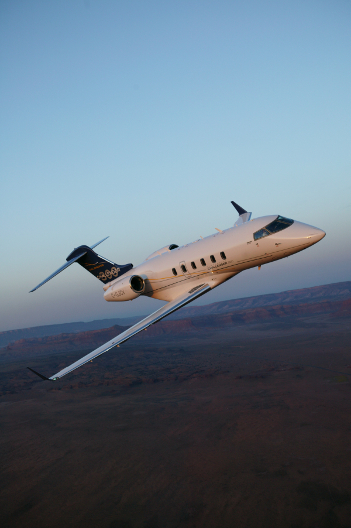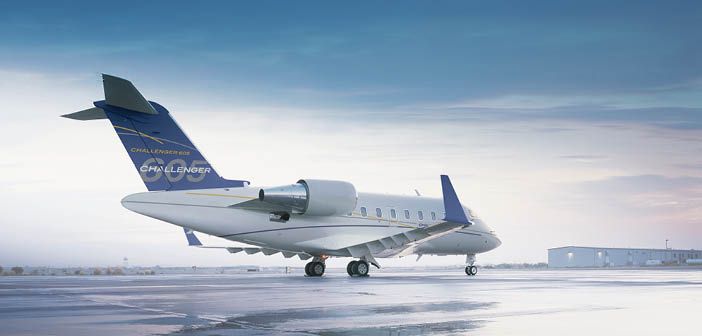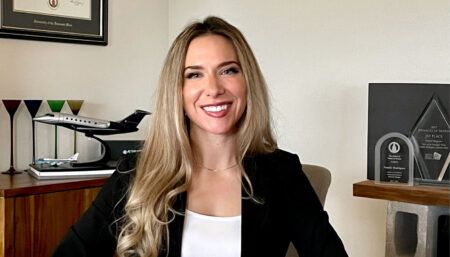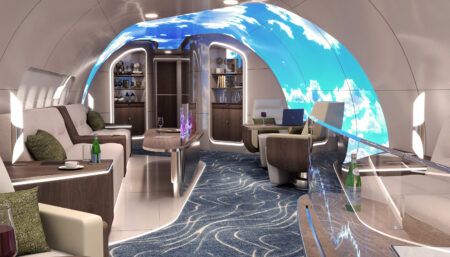Lean manufacturing is making a big difference on Bombardier’s Challenger line
Over the last five years Bombardier has been working hard to implement lean manufacturing techniques and empower employees on its Challenger production line. The majority of Challenger jets are delivered with Bombardier interiors, on schedule. “We’ve come a long way,” says Marc Arpin, director of customer account management on Bombardier’s Challenger programme. “We’ve evolved tremendously since we first started building Challenger interiors in 2004 and have not only increased our efficiency by some 40%, but have made massive leaps in our capabilities.”
Challenger interiors are now completed on a ‘U lean line’, so called because the aircraft are arranged in a ‘U’ shape, each next to a work station on the inside of the ‘U’. There are two ‘U’s – one for Challenger 300 jets and one for Challenger 605 jets. Each station has a specific mission – for example the first installs the harnesses, closes the floor and installs part of the lavatory structure; and the second is responsible for installing part of the headliners, the sidewalls and part of the galley frame. Specialist workers stay at the same station, while after each set period the aircraft are moved on to the next.
Workers don’t have to leave their platforms at all – each is equipped with all the parts needed and backed up with a full support system including a bank of computers and other communication tools for access to engineering, quality assurance, sourcing and other documentation and reference sources.
“In the past, the people that built the aircraft were waiting at the stores to get their parts, coming on to the floor to get their consumables – the rivets, the bolts. It was time-consuming,” says Arpin. “Time saving is what the concept is about. It was done based on us visiting other firms that were specialising in new manufacturing concepts.”
 Proud owners
Proud owners
A key part of the change was about making employees more engaged in the process, giving them ownership of the stations. The supervisors on each station have a symbolic handover when the aircraft moves round the line, and can even veto the move if the previous station hasn’t completed all the scheduled work. If they do allow an aircraft that is behind schedule to progress to their station, that station assumes responsibility for bringing the aircraft back onto schedule.
Arpin believes this change in psychology was at least as important to the facility’s increased efficiency as the lean processes. “Employees are now in the position to make decisions,” he says. “If you bring ownership to the people actually doing the job, they will be even prouder of what they build.” Every worker attends at least one delivery ceremony each year, to foster this pride. “Seeing the end result, the aircraft going to a happy customer – it pays off,” Arpin says.
Quality time
A major pay-off is in the quality of work produced. For example, perhaps one of the most important quality controls for any aircraft manufacturer across the globe is preventing foreign objects from causing damage. Any stray tools that are left unnoticed can cause major problems down the line. Arpin explains: “We look for honesty in our employees, the honesty to take ownership of their jobs, their tools and their mistakes.”
Among the systems implemented to help employees keep track of tools as well as ensure standardisation, are common tool stations providing clear visibility of which tools are out and who has them. At the end of each shift, all tools should be accounted for, thus eliminating the risk of a tool becoming FOD.
Message centre
Communication has also been improved. Each station supervisor takes 15-20 minutes to go through the issues and tasks of the day with their team. “The drive is for them to take ownership of the resolutions and address everything there,” says Arpin.
If, however, there is something that needs to be escalated, the supervisor flags it up for discussion in the managers’ meeting. “The same goes the other way, because the managers could bring issues back to the supervisors about change of priorities, change of schedule, new directives, etc,” says Arpin.
The directors meet to talk about strategic decisions and points escalated by managers from the previous meetings.
One of the functions of the directors’ daily meeting is to go through reports for delivered aircraft, even on those that have been flying for several years. “We’ve kept track of a lot of what we’ve been launching in the system,” says Arpin.
Quality is just one of six key focuses on the shop floor. Another is health and safety. After an incident, directors visit the scene to gain an understanding of why it happened, so measures can be taken to ensure it isn’t repeated – as well as wanting to protect employees from harm, incidents also lead to a reduced workforce. The other key focuses are activity (tracking the schedule of each aircraft); human development; cost; and the Achieving Excellence System (AES) – which involves assessing where there is room for improvement.
 Colour codes
Colour codes
Whiteboards are also used to show the progress of each aircraft in completion, with green and red pins representing current schedule status. “We make it very visual,” says Arpin. “I know that every employee that walks by can actually see this board, every one of them. They can see the reds, they can be concerned; that’s how they get involved.”
To ensure that every employee can see the status of each station, there is a traffic light system that gives a visual queue as to the present status across the production line. A red light will actually halt work at the station and will flag a team of specialists to assist the crew in resolving the issue at hand.
Ongoing challenge
One of the key tenets of lean manufacturing is the idea of continuous improvement. Bombardier started out by implementing the ‘U’ line concept with its Challenger 605s. After a year, it expanded the process to the Challenger 300 line in the hangar next door, incorporating improvements as it did so. The Challenger 605 line was then revamped (about two years ago), based on the lessons learned from that installation. “It’s always an evolving thing,” says Arpin.
Small enhancements included changes to toolings and the platforms themselves – which have been made wider, with wider staircases to make it easier to move parts around. Another enhancement was to add plasma screens at each station, listing the supervisor’s activities for the day. Again, a green, yellow and red light system is used to highlight the status of the various activities on the screen.
The single biggest improvement for the Challenger 605 line was turning it around so that the aircraft doors and workstations align on the inside of the U-line. “Now I can really centralise my efforts and produce the work much more effectively,” declares Arpin.





